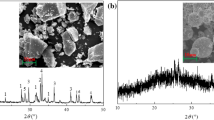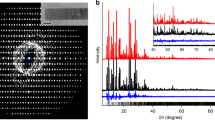Abstract
Heterogeneous catalysis is important in fine-chemical and pharmaceutical manufacture and in petroleum refining1. Many of the catalysts used by these industries are based on aluminosilicates, which combine high stability with excellent activity in acid-mediated reactions2. Within this class of material, zeolites — microporous crystalline aluminosilicates with three-dimensional framework structures — have attracted particular attention: they are significantly more active than the layered structures (clays)3 and mesoporous structures (whose walls are amorphous)4,5, and they impart shape selectivity on the reaction products. The selectivity arises from the fact that the catalytically active acid sites have to be accessed through uniformly sized pores and voids, imposing size constraints on the accessibility to reactants and the nature of the intermediates and products1. Providing access for larger molecules to the catalytic sites would expand the range of reactions that zeolites can catalyse. But attempts to increase the pore size of zeolites6 have met with only limited success. Here we describe an approach in which a layered zeolite precursor7,8 is delaminated, in much the same way as the layered structure of a clay may be unbound. The result is an aluminosilicate whose zeolite-type catalytic sites are contained within thin, readily accessible sheets. Performance tests show that the delamination process improves the accessibility of the catalytic sites without affecting their activity. We expect that our approach could be adapted to other layered zeolite precursors5,7,8,9,10,11, thus paving the way to exfoliated zeolite precursors as a new class of catalysts.
This is a preview of subscription content, access via your institution
Access options
Subscribe to this journal
Receive 51 print issues and online access
$199.00 per year
only $3.90 per issue
Buy this article
- Purchase on Springer Link
- Instant access to full article PDF
Prices may be subject to local taxes which are calculated during checkout



Similar content being viewed by others
References
Maxwell, I. E. & Stork, W. H. J. in Introduction to Zeolite Science and Practice (eds. van Bekkum, H. et al.) 571–630 (Elsevier, Amsterdam, 1991).
Corma, A. Inorganic solids and their use in acid-catalyzed hydrocarbon reactions. Chem. Rev. 95, 559–614 (1995).
Burch, R. Pillared clays. Catal. Today 2, 185–367 (1988).
Corma, A., Grande, M. S., Gonzalez-Alfaro, V. & Orchillés, A. V. Cracking activity and hydrothermal stability of MCM-41 and its comparison with amorphous silica-alumina and USY zeolite. J. Catal. 159, 357–382 (1996).
Corma, A., Fornés, V., Navarro, M. T. & Pérez-Pariente, J. Acidity and stability of MCM-41 crystalline aluminosilicates. J. Catal. 148, 569–575 (1994).
Barrer, R. M. Hydrothermal Chemistry of Zeolites (Academic, London, 1982).
Roth, W. J. et al. in Catalysis by Microporous Materials (eds Beyer, H. K. et al.) 301–308 (Elsevier, Amsterdam, 1991).
Lawton, S. et al. Zeolite MCM-49: a 3-dimensional MCM-22 analog synthesized by in-situ crystallization. J. Phys. Chem. 100, 3788–3798 (1996).
Whittam, Th. V. Zeolites. Eur. Patent 0054364 (1982).
Schreyeck, L., Caullet, P., Mougenel, J. C., Guth, J. L. & Marier, B. Prefer: a new layered (alumino) silicate precursor of FER-type zeolite. Microporous Mater. 6, 259–271 (1996).
Lohse, U. et al. Synthesis of zeolite-beta. Formation of zeolite-beta and titanium-beta via an intermediate layer structure. J. Chem. Soc. Faraday Trans. 93, 505–512 (1997).
Freyhardt, C. C., Tsapatsis, M., Lobo, R. F., Balkus, K. J. J & Davis, M. E. Ahigh-silica zeolite with a 14-tetrahedral-atom pore opening. Nature 381, 295–298 (1996).
Corma, A., Fornés, V. & Pergher, S. B. EP (Spanish patent) 9502188 (1996); PCT-WO Patent 97/17290 (1997).
Leonowicz, M. E., Lawton, J. A., Lawton, S. L. & Rubin, M. K. MCM-22: a molecular sieve with two independent multidimensional channel systems. Science 264, 1910–1913 (1994).
Fung, A. S., Ford, C. H., Lawton, S. L. & Roth, W. J. Synthetic layered MCM-56, its synthesis and uses.US Patent 5362697 (1994).
Cerius2 Biosym/Molecular Simulations Inc., SanDieg, 1995).
Acknowledgements
We thank C. H. Roemkens for comments on the manuscript, and R. Haswell for assistance with the supplementary TEM work.
Author information
Authors and Affiliations
Corresponding author
Supplementary information
Supplementary Information
Supplementary material for the article (DOC 635 kb)
Rights and permissions
About this article
Cite this article
Corma, A., Fornes, V., Pergher, S. et al. Delaminated zeolite precursors as selective acidic catalysts. Nature 396, 353–356 (1998). https://doi.org/10.1038/24592
Received:
Accepted:
Issue Date:
DOI: https://doi.org/10.1038/24592
This article is cited by
-
Toward the production of renewable diesel over robust Ni nanoclusters highly dispersed on a two-dimensional zeolite
NPG Asia Materials (2023)
-
Synthesis of Ti-MWW Zeolite by Refluxing and Implanting Titanium Method and Further Application in 1-Hexene Epoxidation
Catalysis Letters (2023)
-
The effect of amorphous silica support on the catalytic activity of liquid-exfoliated monolayered MCM-56 zeolite
Journal of Porous Materials (2023)
-
Ruthenium-containing MCM-22 and ITQ-2 as potential redox catalysts for benzhydrol oxidation
Journal of Porous Materials (2022)
-
Zeolite-based nanocomposite as a smart pH-sensitive nanovehicle for release of xylanase as poultry feed supplement
Scientific Reports (2021)
Comments
By submitting a comment you agree to abide by our Terms and Community Guidelines. If you find something abusive or that does not comply with our terms or guidelines please flag it as inappropriate.



